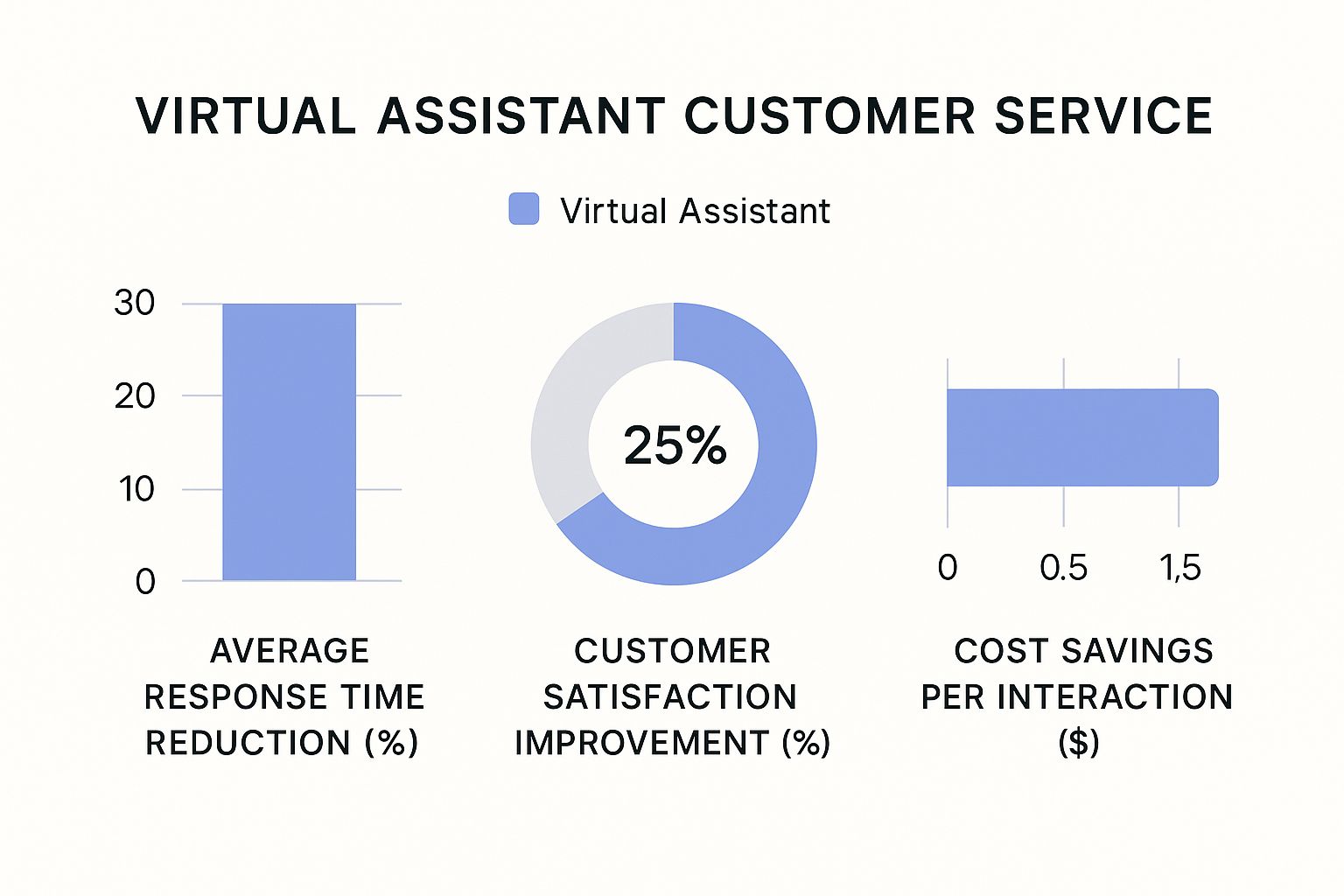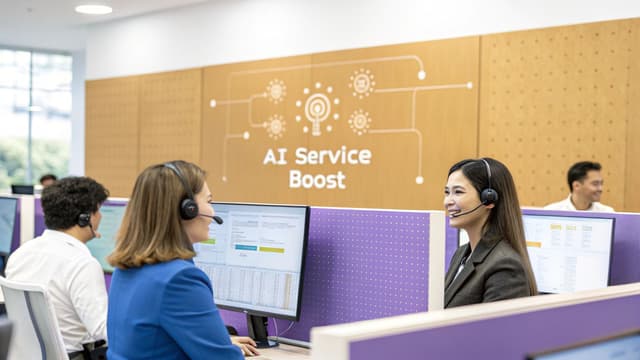The Evolution of Virtual Assistant Customer Service

Virtual assistant customer service has evolved significantly. Early chatbots offered a glimpse into the possibilities of automated support, but their limited capabilities often led to frustrating user experiences. Now, thanks to advancements in artificial intelligence (AI) and natural language processing (NLP), today's virtual assistants are changing how businesses interact with customers. These AI-driven tools are no longer just about saving money; they're valuable assets that can improve the overall customer experience.
From Basic Bots to Strategic Partners
Businesses initially saw virtual assistants as a way to automate simple, repetitive tasks like answering basic FAQs and directing customers to the appropriate resources. The inability of early virtual assistants to understand complex language or offer personalized interactions hampered their effectiveness. However, this perception is changing.
Modern virtual assistant customer service now provides a much wider range of services. These include personalized recommendations, proactive problem-solving, and seamless transitions to human agents when required. This expanded functionality signifies a move toward more sophisticated and helpful customer interactions.
The Rise of Specialized Virtual Assistants
Imagine a virtual assistant that understands a customer's technical problem and accesses their account history and past interactions to offer a personalized solution. This level of service is now possible. Today's sophisticated virtual assistants can integrate with existing CRM systems, ticketing platforms, and order management tools to provide comprehensive, context-aware support.
This trend toward specialization leads to greater efficiency and higher customer satisfaction. The virtual assistant market is expected to reach $25.63 billion by 2025, growing at an annual rate of 30%. Furthermore, by 2025, approximately 40% of virtual assistants are projected to offer specialized services in areas like IT, legal, and medical support. This specialization reflects the increasing need for targeted customer service. For more detailed statistics, check out this resource: Virtual Assistant Statistics.
The Impact of AI on Customer Service Efficiency
AI integration has made virtual assistants better at handling customer inquiries independently, helping to reduce support tickets. This allows human agents to concentrate on more complex issues, optimizing their skills and improving overall team productivity.
Furthermore, AI-powered virtual assistants offer 24/7 availability, allowing businesses to provide continuous support to a global customer base. This constant availability boosts customer satisfaction and strengthens brand loyalty. Virtual assistants are shifting from basic automation to strategic customer engagement, creating a synergy between human agents and AI for a better customer and support team experience.
The Measurable Impact: Transforming Response Metrics

How does virtual assistant customer service truly affect performance? This section explores the tangible improvements these solutions bring to support operations. We'll examine how virtual assistants, particularly those powered by platforms like FlowGent AI, transform key response metrics.
Decreased Response Times, Improved Resolution Quality
One of the most significant advantages of virtual assistant customer service is the dramatic reduction in response times. Customers no longer face long waits, leading to higher satisfaction. This improvement also allows human agents to dedicate their time to more complex issues.
This streamlined approach maximizes their skills and efficiency. Integrating AI-powered tools can cut resolution times by up to 50% through automation and predictive support. This rapid response enhances customer experience and frees up human agents for more demanding tasks.
Additionally, implementing AI in customer service can lead to a 37% decrease in first response times. Automation can also boost repeat purchases by 36%, demonstrating improved customer engagement through faster service. For more in-depth statistics, check out these AI Customer Service Statistics.
Impact on Key Metrics: A Visual Representation
The following data chart illustrates the positive effects virtual assistants have on several key customer service metrics. This data is based on aggregated performance across various FlowGent AI deployments.
[INFOGRAPHIC WILL BE PLACED HERE]
This chart highlights significant improvements in average and first response times, resolution rate, and customer satisfaction after implementing virtual assistants. The data reveals a considerable reduction in wait times and a noticeable increase in successful resolutions and overall customer happiness.
To further illustrate these improvements, let's look at a table summarizing the impact:
This table, titled "Virtual Assistant Impact on Key Customer Service Metrics," presents before-and-after measurements showing how virtual assistant implementation affects critical customer service performance indicators.
| Performance Metric | Before Virtual Assistant | After Virtual Assistant | Improvement |
|---|---|---|---|
| Average Response Time (seconds) | 120 | 30 | 90 seconds |
| First Response Time (seconds) | 60 | 20 | 40 seconds |
| Resolution Rate (%) | 75 | 90 | 15% |
| Customer Satisfaction (%) | 70 | 85 | 15% |
The table clearly demonstrates the significant positive impact of virtual assistants across these key metrics.
The Role of Intelligent Routing and Sentiment Analysis
Virtual assistants excel at routing inquiries to the correct department or agent. This ensures customers receive prompt and appropriate assistance. By leveraging customer interaction analytics to recognize customer sentiment, virtual assistants can adapt responses and seamlessly escalate complex or emotionally charged situations to human agents. This proactive approach prevents negative experiences and maintains customer satisfaction. For a deeper understanding of the development of AI in call centers, read more about the Evolution of Call Center AI.
Connecting Improvements to Business Outcomes
These enhancements directly contribute to crucial business outcomes. Reduced operational costs, increased customer retention, and improved satisfaction scores are all tangible benefits of virtual assistant customer service. This technology empowers organizations to enhance support, drive growth, and improve overall business performance.
Beyond Algorithms: Creating Authentic AI Connections

Can virtual assistants truly connect with customers on a human level? This question prompts a reevaluation of how we perceive AI and empathy. This section explores how advanced virtual assistants are using emotional intelligence to craft more authentic and engaging customer interactions. For instance, AI can now detect frustration in customer communications, modify its tone accordingly, and offer personalized support based on individual history and preferences.
Recognizing and Responding to Customer Emotions
Advanced virtual assistants, such as those powered by FlowGent AI, move beyond simply processing words. They analyze the nuances of language, including tone and sentiment, to gain a deeper understanding of the customer’s emotional state. This allows the virtual assistant to tailor its response with empathy and understanding when a customer expresses frustration.
This responsiveness to emotional cues creates a more personalized and human-like experience. It allows the AI to build rapport with customers, leading to more positive interactions. Furthermore, these virtual assistants can personalize interactions based on data stored in connected CRM systems.
They can offer tailored solutions and product recommendations based on individual customer needs. This level of personalization strengthens customer relationships and fosters loyalty. By understanding and responding to individual needs, businesses can create a more positive and valuable customer experience.
The Psychology of Authentic Interactions
Creating authentic interactions goes beyond mimicking human language. It involves understanding the psychological factors that contribute to positive interactions. These factors include active listening, mirroring the customer’s language, and offering appropriate emotional responses. Leading organizations are incorporating these elements into their virtual assistant design to cultivate genuine connections.
However, balancing efficiency with authenticity presents a challenge. While automation streamlines processes, it’s essential to ensure interactions don’t feel robotic or impersonal. This requires careful planning and consideration. Businesses must strategically determine which interactions are best suited for automation and which require a human touch.
Building Trust Through Transparency and Ethical Considerations
Nearly one-half of customers believe AI agents can be empathetic when addressing their concerns. This perception is increasingly relevant as AI is projected to handle 95% of all customer interactions by 2025. This statistic reflects a growing trend of developing AI tools that simulate human-like interactions to improve customer satisfaction.
The successful implementation of AI in customer service has also resulted in significant cost savings, with some businesses reporting up to a 68% reduction in staffing costs during peak times. Find more detailed statistics here. Transparency also plays a vital role in building trust.
Openly communicating the role of AI in customer service can alleviate concerns and foster confidence. This involves addressing the ethical implications of emotional AI, ensuring responsible and respectful use. By analyzing real customer feedback and case studies, businesses can develop a practical approach that leverages AI’s efficiency while retaining the human element that customers value.
Your Virtual Assistant Implementation Blueprint
Bringing the efficiency and convenience of virtual assistants to your customer service requires a solid plan. This blueprint will guide you through the key steps, from the initial assessment to ongoing improvements, ensuring a smooth transition and maximizing the potential of virtual assistant customer service.
Needs Assessment and Goal Setting
Before introducing any new technology, it's essential to understand your specific requirements. Start by carefully examining your current customer service operations. Look for areas where automation can have the biggest positive impact, such as bottlenecks, periods of high demand, and repetitive tasks. For example, are customers regularly facing long wait times? Is your team overloaded with frequently asked questions?
Once you've identified your needs, establish clear, measurable goals. These objectives might include improving response times, boosting customer satisfaction, or increasing resolution rates. Having specific goals allows you to monitor progress and demonstrate the value of your investment in virtual assistants. This initial assessment forms the bedrock of a successful implementation.
Technology Partner Selection and Integration
Selecting the right technology partner is critical. Evaluate different platforms like FlowGent AI, considering factors such as scalability, customization options, and integration with your existing systems, including CRM and ticketing platforms. FlowGent AI, for example, provides a no-code platform that integrates smoothly for streamlined deployment.
Ensure the chosen platform adheres to your data security standards and any necessary industry regulations. A secure and compliant solution protects your customer data and fosters trust. A thorough selection process will result in a more efficient and successful implementation.
Training, Testing, and Optimization
Comprehensive training is essential for both your virtual assistant and your human team. Train the virtual assistant on your specific products, frequently asked questions, and customer service procedures to ensure accurate and helpful responses. At the same time, train your human agents on collaborating effectively with the virtual assistant, including escalation processes and handoff protocols.
Testing should be a continuous process. Regularly evaluate the virtual assistant's performance in simulated scenarios and gather feedback from both customers and agents. This continuous feedback loop enables you to identify areas for improvement and refine the virtual assistant’s responses. Ongoing optimization keeps the virtual assistant relevant and effective in meeting changing customer needs.
Team Transition and Performance Management
Introducing virtual assistant customer service requires careful management of team transitions. Communicate the virtual assistant's role to your team clearly, emphasizing it as a support tool, not a replacement for human interaction. Establish clear performance metrics for both the virtual assistant and your agents. These metrics should align with your overall business goals and reflect the collaborative nature of human-AI support.
It's crucial to set realistic performance expectations. Understand that the virtual assistant might require adjustments over time to reach optimal performance. Regularly monitoring and analyzing performance data will reveal areas for improvement and allow you to adjust your strategies. This iterative process is key to maximizing the effectiveness of your virtual assistant customer service.
Cost-Effective Approaches and ROI
Implementing virtual assistant customer service can be a cost-effective solution, particularly for budget-conscious businesses. Consider starting with a pilot program focused on specific customer service functions. This lets you test and refine your approach before a full rollout. Gradually expanding the virtual assistant's responsibilities as performance improves ensures a smooth transition and minimizes disruptions.
Track key performance indicators (KPIs) like response times, resolution rates, and customer satisfaction to measure the return on investment (ROI). This data-driven approach demonstrates the tangible benefits of implementing a virtual assistant and justifies further investment. Focusing on cost-effective implementation and tracking ROI allows organizations to maximize the impact of their virtual assistant customer service.
To help guide your implementation, refer to the checklist below:
Virtual Assistant Customer Service Implementation Checklist: A comprehensive checklist for businesses at different stages of implementing virtual assistant solutions.
| Implementation Phase | Key Actions | Common Pitfalls | Success Indicators |
|---|---|---|---|
| Needs Assessment | Analyze current operations, identify pain points, define goals | Lack of clear objectives | Clearly defined needs and measurable goals |
| Technology Selection | Evaluate platforms, consider integration capabilities, ensure security compliance | Choosing a platform that doesn’t integrate with existing systems | Seamless integration with existing CRM and ticketing platforms |
| Training and Testing | Train virtual assistant and human agents, conduct regular testing and gather feedback | Insufficient training leading to inaccurate responses | Improved virtual assistant accuracy and agent proficiency |
| Team Transition | Communicate clearly with the team, establish performance metrics | Resistance to change from support staff | Smooth transition and team adoption of the virtual assistant |
| Optimization and ROI | Monitor KPIs, refine strategies, demonstrate cost savings | Failing to track ROI and optimize performance | Measurable improvements in response times, resolution rates, and customer satisfaction |
This checklist provides a practical framework for navigating the various stages of implementation. By addressing the key actions, avoiding common pitfalls, and focusing on the success indicators, you can effectively integrate virtual assistants into your customer service operation.
By following this blueprint, you can successfully implement virtual assistant customer service, transforming your support operations and improving the customer experience. This comprehensive roadmap ensures a smooth transition and sets your business up for future growth and success in the dynamic world of customer service.
The Human-AI Alliance: Redefining Support Roles

The most effective customer service strategies aren't about replacing human agents with AI. They're about empowering them. Instead of eliminating jobs, smart companies are using platforms like FlowGent AI to blend human expertise with the efficiency of AI. This creates a powerful synergy that elevates the entire customer experience.
Transforming Job Descriptions and Skill Sets
This shift towards human-AI collaboration means adapting job descriptions. Customer service agents, for example, can move away from handling basic inquiries and into specialized roles. These roles might involve complex problem-solving and delivering truly personalized support. This allows human agents to focus on the nuanced interactions AI might find challenging, like emotionally charged situations or issues requiring deep product knowledge.
This also changes the essential skill sets for customer service roles. Agents need training to effectively collaborate with AI assistants. Understanding AI's capabilities and limitations is crucial, along with the ability to interpret data analytics to optimize performance. This evolution requires a focus on upskilling and continuous learning to meet the changing demands of the field.
Collaborative Workflows for Maximum Effectiveness
Successful human-AI partnerships rely on well-designed workflows. This includes clear escalation paths for when a virtual assistant needs to hand off an interaction to a human agent. A virtual assistant might handle initial inquiries and gather basic information, then seamlessly transfer the conversation to a human agent when empathy or complex problem-solving is needed.
This creates a smooth and efficient customer journey. Clear communication between the virtual assistant and human agents is essential for maintaining context and providing a unified customer experience. Platforms like FlowGent AI make this integration smoother by enabling seamless handoffs and information sharing.
Addressing Job Security Concerns and Empowering Agents
Integrating AI into the workplace can raise concerns about job security. However, successful organizations frame virtual assistants as tools that enhance, not replace, human capabilities. By automating repetitive tasks, virtual assistants free up human agents to focus on higher-value interactions. This allows them to concentrate on empathy, critical thinking, and building relationships with customers.
This shift positions customer service as a more strategic and fulfilling career path. Emphasizing the collaborative nature of human-AI partnerships empowers agents and fosters a positive work environment. The result is a more dynamic and rewarding field for customer service professionals.
Emerging Specialized Roles and the Future of Customer Service
As AI evolves, we're seeing new specialized roles emerge within customer service. These roles might include AI trainers who specialize in optimizing AI performance, conversation designers who create engaging and effective AI interactions, and customer experience analysts who use AI-generated data to improve overall customer satisfaction.
This elevates customer service into a more strategic and valuable asset for businesses. By embracing the potential of human-AI collaboration, organizations can create a more efficient and personalized customer experience. The future of customer service isn't about replacing humans with AI, but about empowering them with AI capabilities. This creates a future where technology strengthens human connection, not weakens it.
The Future of Virtual Assistant Customer Service
Virtual assistant customer service is constantly changing. This section explores emerging technologies set to define the next generation of customer support. We'll look at advancements like natural language processing (NLP), emotion recognition, predictive analytics, and multimodal interactions, shaping the future of customer engagement.
Emerging Technologies and Their Impact
Imagine a virtual assistant that understands not just your words but also your feelings. This is the potential of emotion recognition, where AI analyzes vocal tone and text to understand customer sentiment. This lets virtual assistants adapt, offering empathy during difficult situations and escalating complex issues to human agents smoothly.
Predictive analytics enables virtual assistants to anticipate customer needs. For example, if a customer regularly contacts support about a specific product feature, the virtual assistant can proactively offer helpful resources or tutorials. This proactive approach solves problems before they arise.
Creating Intuitive Support Experiences Through Technological Convergence
Technologies like augmented reality (AR), advanced voice recognition, and machine learning are combining to create intuitive support experiences. AR could overlay instructions onto a product, guiding customers visually through troubleshooting. Advanced voice recognition enables more natural interactions, allowing customers to talk to virtual assistants like they would a human.
These advancements work together to create a seamless, personalized experience. Businesses can now offer support in entirely new ways, making the customer journey more intuitive and enjoyable, ultimately improving satisfaction and loyalty.
From Reactive Support to Proactive Engagement
Forward-thinking organizations are moving beyond reactive support towards proactive engagement. Virtual assistants can now identify and resolve potential issues before customers report them.
By analyzing customer data and usage patterns, AI can predict and address problems. This could involve proactively sending payment reminders or offering personalized product recommendations based on past purchases. This strengthens customer relationships and reduces the need for reactive support.
Future-Proofing Your Customer Service Strategy
Staying competitive in customer service means embracing these technological advances. Organizations need to invest in training their teams to work effectively with AI. They also need to continuously evaluate and optimize their virtual assistant strategies.
This proactive approach to implementation and ongoing optimization is key to maximizing the benefits of virtual assistant customer service. By adopting these technologies, businesses can improve their support operations, boost customer satisfaction, and gain a competitive edge. Ready to transform your customer service with AI? Explore the power of FlowGent AI and discover how our no-code platform can enhance your customer support.



